To view previous releases, select one from the dropdown box:
Currently displaying information released on: January, 2024
EU AND EURO AREA CONSUMER PRICE INDEX, DECEMBER AND ANNUAL 2023
Year-over-year (December 2023 vs December 2022)
The inflation rate picked up to 3.4% in the European Union and to 2.9% in the Euro Area in December 2023.
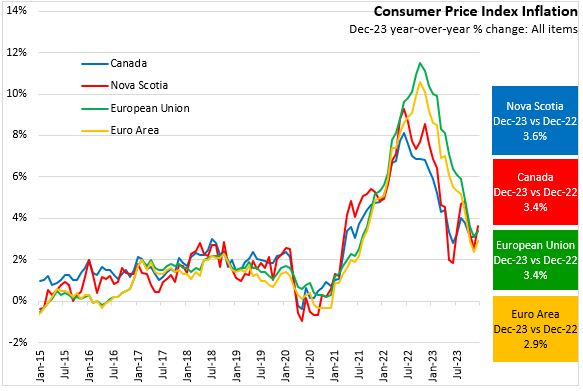
The fastest inflation was reported in Czechia (7.6%) and Romania (7.0%) while the slowest inflation rate was in Denmark (0.4%), Italy and Belgium (0.5%).
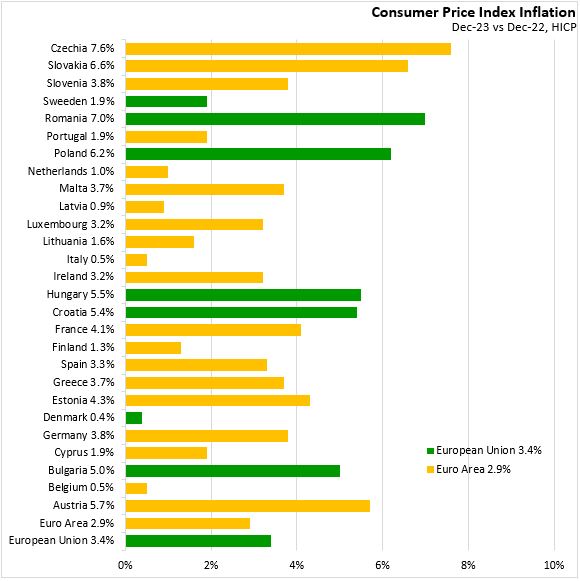
Energy prices declined 5.0% in the European Union and declined 6.7% in the Euro Area in December 2023.
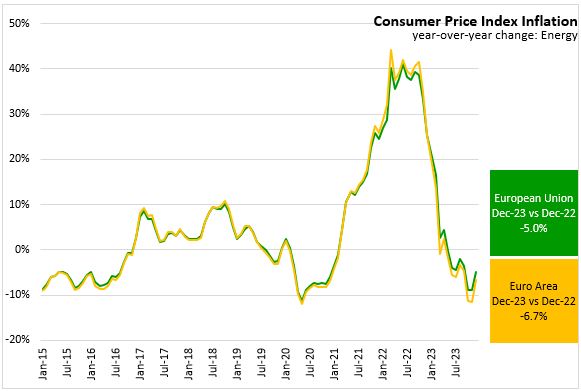
Food price inflation has continued to slow but remains elevated at 5.7% for the European Union and 6.0% the Euro Area in December 2023.
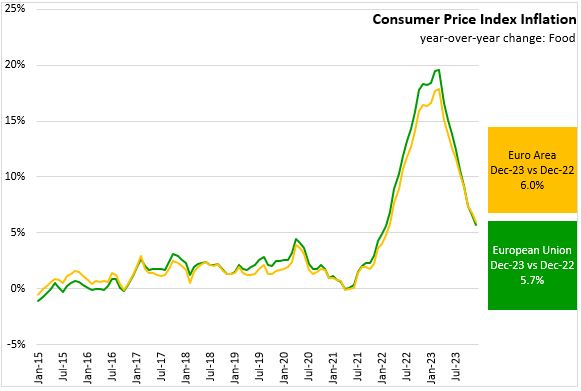
Excluding the impacts of energy, food, alcohol and tobacco prices year-over-year inflation was slowed to 4.0% in the European Union and 3.4% in the Euro Area in December 2023.
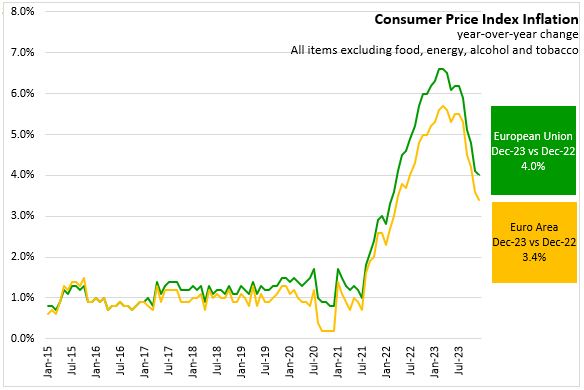
ANNUAL 2023
In the European Union, inflation slowed to 6.4% in 2023 from 9.2% in 2022. In the Euro Area, inflation was 5.4% in 2023, down from 8.4% in 2022.
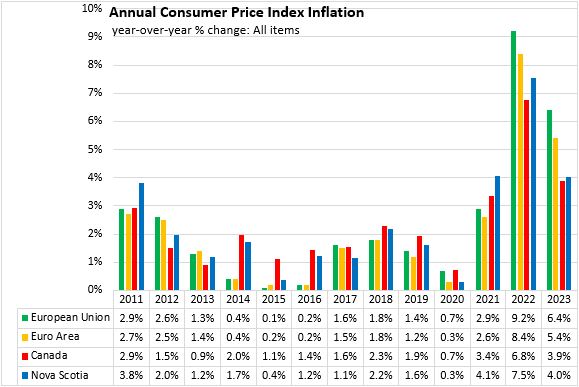
Source: Eurostat ANALYSIS OF CONSUMER PRICE INDEX FOR DECEMBER & ANNUAL 2023
Nova Scotia’s all items Consumer Price Index (CPI) increased 3.6% year-over-year in December 2023, up from a pace of 2.5% year-over-year in November. December all items CPI was down 0.2% compared to the previous month. Statistics Canada noted that the rise in national inflation reflects a base-year effect with gasoline prices down more on a monthly basis in December 2022 compared to December 2023. Excluding gasoline, Nova Scotia's year-over-year inflation was 3.5% in December 2023, up from 2.9% in November.
Nova Scotia's inflation had been slowing after peaking at 9.3% in June 2022. Inflation started to accelerate again in July 2023, particularly due to gasoline prices, as the large monthly drop in July 2022 is no longer included in 12-month calculations while Federal carbon charges came into effect over the summer. However, in October 2022 there was an increase in global oil prices as a result of OPEC production cuts, which drove up fuel prices in the fall of last year. As global oil prices have since retreated, energy prices declined on a year-over-year basis in October and November 2023.
Nationally, consumer prices increased 3.4% year-over-year in December 2023, up from 3.1% in November. Inflation was highest in Québec and slowest in Manitoba.
The most significant upward contributors (combining price increase as well as share of the consumption basket) to Nova Scotia's 3.6% year-over-year inflation were: rent,
mortgage interest cost, gasoline, food purchased from restaurants, and purchase and leasing of passenger vehicles. These were offset by downward year-over-year contributions from: telephone services, fuel oil and other fuels, internet access services, home entertainment equipment/parts/services, and child care and housekeeping services.
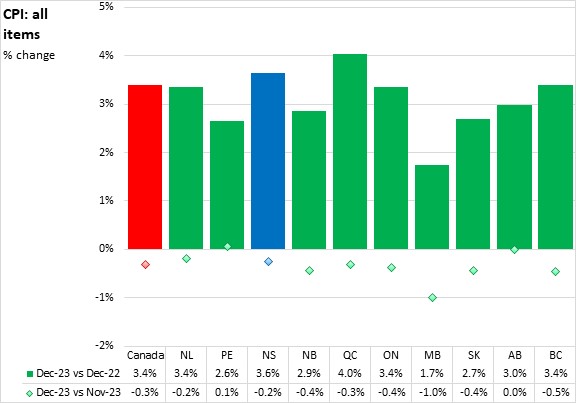
On a monthly basis, Nova Scotia's all items CPI was down 0.2% from November to December 2023. National prices were down 0.3% with decreases reported in eight provinces. Manitoba reported the fastest percentage decline on a monthly basis. Prince Edward Island reported the only monthly increase.
Nova Scotia's monthly inflation was influenced by upward contributions from: inter-city transportation, purchase and leasing of passenger vehicles, passenger vehicle insurance premiums, rent, and mortgage interest cost. These upward contributors to Nova Scotia's monthly CPI were offset by some notable downward contributors: travel tours, gasoline, household appliances, home entertainment equipment/parts/services, and telephone services.
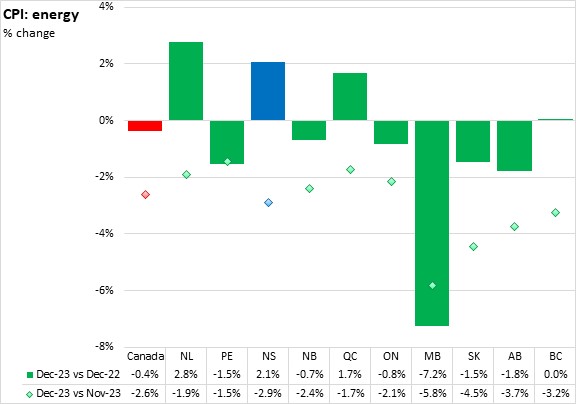
Energy prices play a significant role in inflation rates. Nova Scotia's energy prices were up 2.1% from December 2022 to December 2023. Year-over-year energy prices were down 0.4% nationally with decreases in six provinces. Manitoba reported the largest decline while Newfoundland and Labrador reported the fastest increase.
On a monthly basis, Nova Scotia's energy prices decreased 2.9% from November to December 2023. National energy prices were down 2.6% with declines in all provinces. Manitoba reported the largest monthly decrease in energy prices while Prince Edward Island posted the smallest monthly decline.
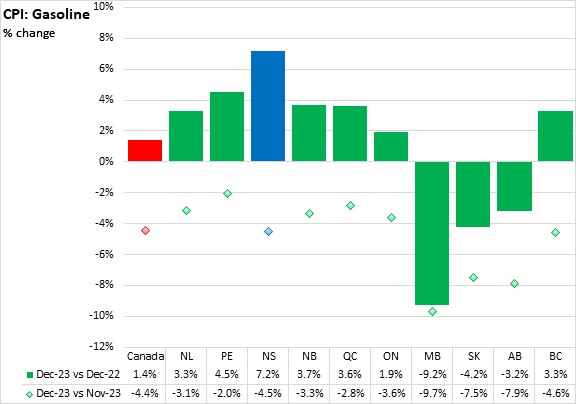
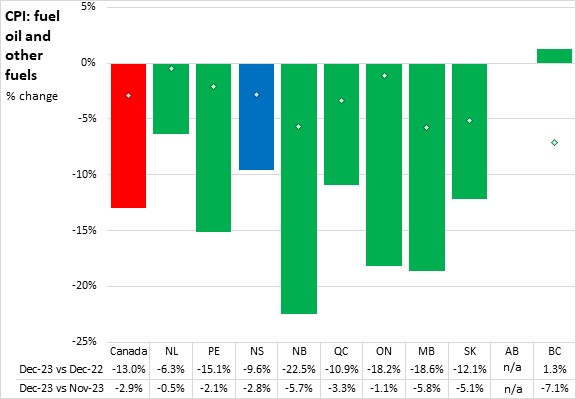
Because fuel oil for home heating is a larger component of Nova Scotia's consumption basket than in other provinces, Nova Scotia's energy prices (and overall inflation) are more sensitive to fluctuations in the global price of crude oil. Nova Scotia's energy prices accelerated dramatically after Russia's invasion of Ukraine in March 2022. Nova Scotia energy prices peaked in June 2022, and then trended down before rising substantially in October and November 2022 as the Organization of Petroleum Exporting Countries cut production to raise global oil prices. Energy prices in Nova Scotia rose again in July 2023 with the introduction of the federal carbon levy.
Nova Scotia's year-over-year price decline for fuel oil was 9.6%. Gasoline prices increased 7.2% compared to a year ago, up from a 4.9% decline in November. The increase in gasoline prices reflect a strong base year effect with gasoline prices dropping 15.3% in December 2022 before recovering in July 2022.
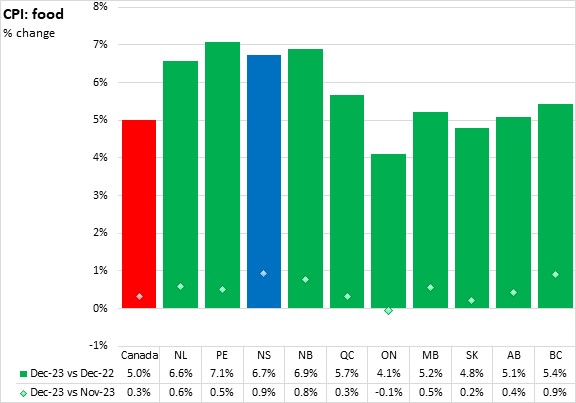
Food price inflation was 6.7% in Nova Scotia (December 2023 vs December 2022). National food prices increased 5.0% in December. Food prices were up in all provinces; the Atlantic Provinces reported the highest food price inflation while Ontario reported the least food price growth (though it was still 4.1%).
On a monthly basis, Nova Scotia's food prices rose 0.9% from November to December. National food prices were up 0.3% with increases in all provinces except Ontario (where food prices declined month-to-month). Nova Scotia and British Columbia reported the fastest increase in food prices.
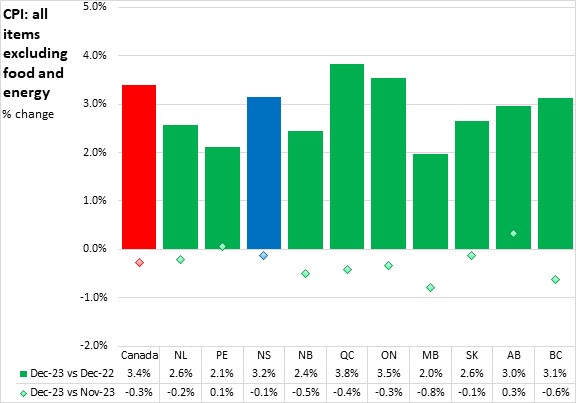
Food and energy prices are heavily influenced by volatile global commodity markets. Nova Scotia's underlying inflation rate excluding food and energy was 3.2% from December 2022 to December 2023. Nationally, inflation excluding food and energy was 3.4%. Quebec reported the fastest growth while Manitoba reported the slowest growth in inflation excluding food and energy prices.
On a monthly basis, Nova Scotia's inflation for all items excluding food and energy was down 0.1% from November to December 2023. Nationally, prices for all items excluding food and energy were down 0.3% with decreases in eight provinces. Manitoba reported the largest monthly decline while Alberta and Prince Edward Island reported the only increases.
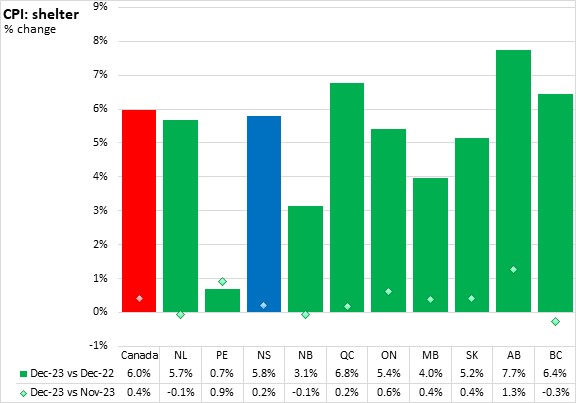
Year-over-year shelter cost inflation accelerated to 5.8% in Nova Scotia in December 2023, up from 3.9% in November. National shelter prices were up 6.0% with gains in all provinces. Alberta reported the largest year-over-year increase in shelter prices while Prince Edward Island reported the slowest increase.
Monthly shelter costs were up 0.2% in Nova Scotia from November to December 2023. Nationally, shelter costs were up 0.4% with gains in seven provinces. The fastest monthly growth in shelter costs was in Alberta. Newfoundland and Labrador, New Brunswick and British Columbia reported monthly declines in shelter costs.
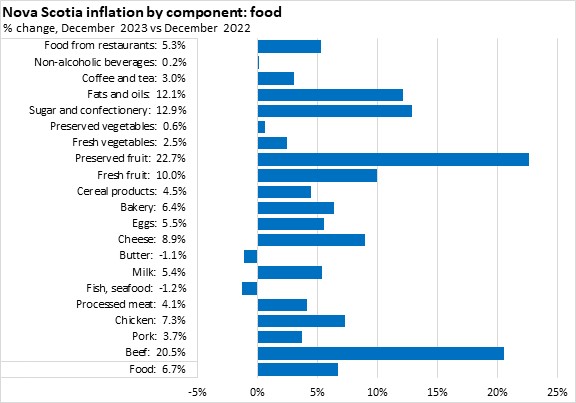
Among detailed food products with available data, Nova Scotia's year-over-year inflation was fastest for preserved fruit and beef. Lower year-over-year prices were reported for butter and fish/seafood.
In detailed shelter cost components, rent reported the fastest year-over-year price increase, followed by home/mortgage insurance and electricity. Fuel oil reported the largest year-over-year decline.
Household operations/furnishings costs were down 3.4% overall. Prices were down for all components except cleaning products and paper, plastic and aluminium products. The largest declines were in telephones, child care/housekeeping and internet.

Overall transportations costs were up 4.1% year-over-year in December. Inter-city transportation had the largest decline while taxi/other local transportation had the largest increase.
Health and personal care costs were up 4.7% year-over-year on gains in all sub-components led by personal care services.
Clothing and footwear prices were up 2.0% year-over-year in December with increases in all categories except men's and women's clothing. Clothing accessories and jewellery reported the largest increase in December, followed by clothing materials and services.
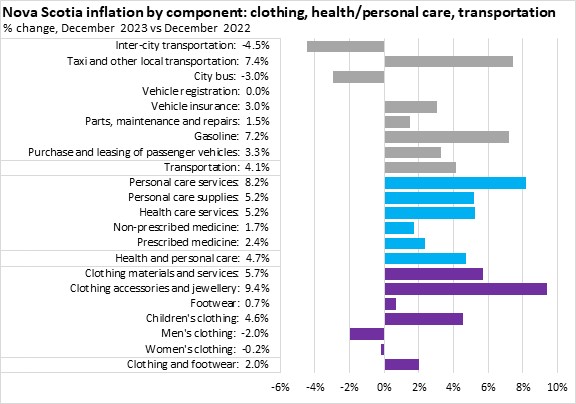
Nova Scotia's overall prices for recreation, education and reading were up 2.9% from December 2022 to December 2023, with faster increases for travel services/accommodations and purchase/operation of recreational vehicles. Prices declined from the previous year for recreational equipment/services (excluding RVs) and home entertainment equipment and services.
Nova Scotia's prices for alcohol, tobacco and recreational cannabis were up 3.2% year-over-year with growth in all categories led by cigarette prices.
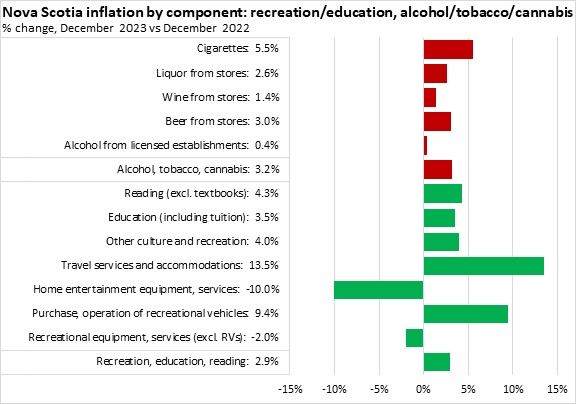
Trends
Since the start of the Bank of Canada's inflation-targeting monetary policy regime, inflation for all items has generally been in the 0-4% range. Periods of above target inflation are typically followed by periods of slow price growth or declines. The most recent acceleration in inflation was the strongest since the inflation-targeting era began, though this inflation is starting to fade with tighter monetary policy and lower commodity prices.
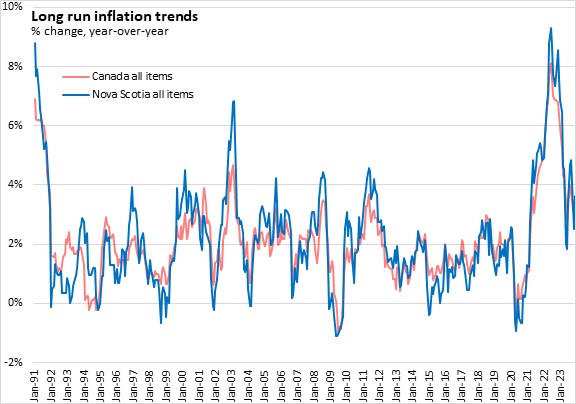
Many of these periods of accelerated and slowed inflation are attributable to volatile commodity prices, especially energy prices. Once the more volatile commodity prices are excluded, inflation in Nova Scotia has largely been below 2% for much of the last 20 years. However, the recent rise in inflation through 2021-2023 spreads beyond commodity prices, resulting in the longest period under the Bank of Canada's inflation-targeting regime with Nova Scotia's CPI excluding food and energy above 3%.
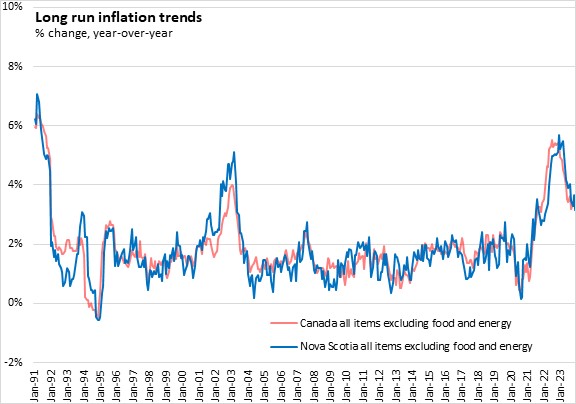
The Bank of Canada examines 'core' measures of inflation that are intended to remove the effects of volatile components and capture underlying inflation trends that are more connected to capacity in the Canadian economy. Core measures of inflation may also indicate where all items inflation is headed.
Canada's core measures of inflation remained mostly at or below the Bank's target of 2% for over a decade prior to 2021. However, after prices accelerated in 2022, core inflation measures also started to rise, peaking at over 6% for the CPI-common measure before declining. Compared to the previous month, year-over-year core inflation measures in December 2023 were unchanged for CPI-common (3.9%) and CPI-median (3.6%), up for CPI-trim (3.7%) and down for CPI-core (2.6%).
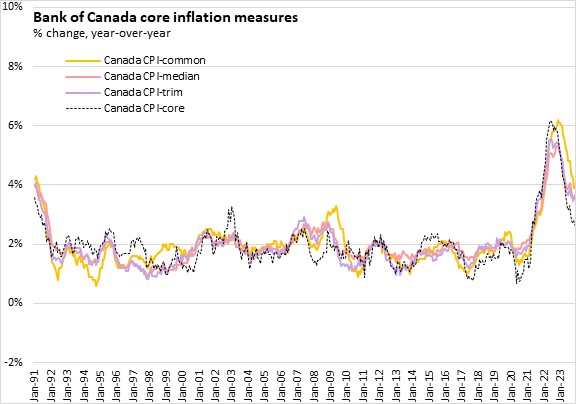
ANNUAL (2023 vs 2022)
The annual average of Nova Scotia’s all items CPI slowed to 4.0% growth in 2023, compared to 7.5% average inflation in 2022. Nationally, consumer prices increased 3.9% in 2023 down from 6.8% in 2022. On average, Quebec had the highest inflation in 2023 while Prince Edward Island had the lowest inflation. All provinces reported decelerating price growth compared to 2022.
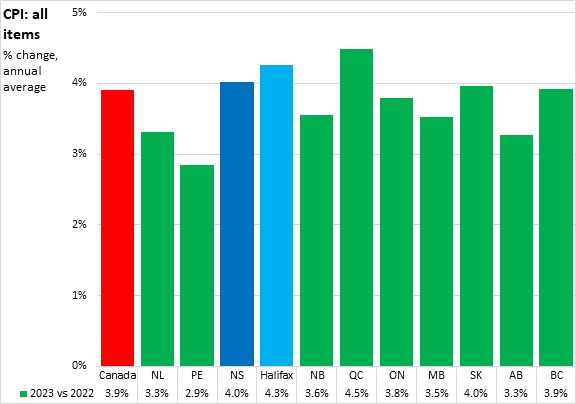
Nova Scotia's energy prices decreased 3.2% in 2023, slower than the national decline of 4.2%. All provinces reported declining energy prices in 2023, with the fastest decreases in Prince Edward Island and Alberta, and the slowest decrease in Saskatchewan.
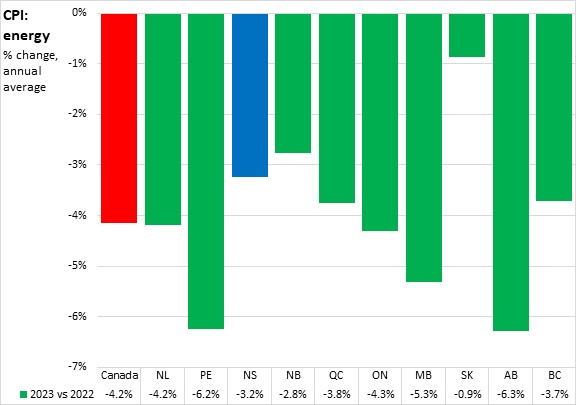
Nova Scotia's food price inflation averaged 7.9% in 2023, faster than the national increase of 7.5%. All provinces reported rising food prices in 2023 with the fastest increase in Quebec and the slowest increases in Ontario and British Columbia (where food inflation was still at 7.1%). Food inflation slowed for all provinces compared to 2022.
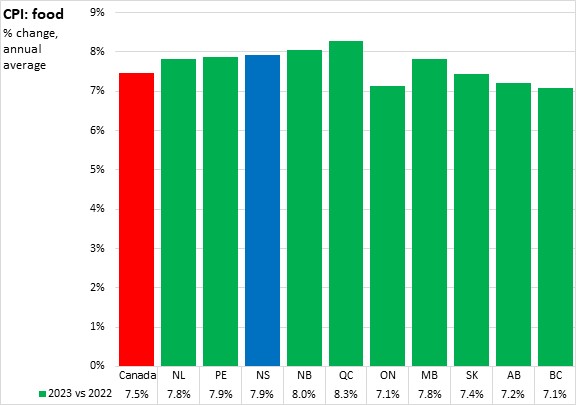
Nova Scotia's all items CPI excluding food and energy prices averaged 4.2% inflation in 2023, the second fastest among provinces. Nationally, the increase in prices excluding food and energy was 3.9%. All provinces reported higher prices with the fastest gains in Quebec and the slowest in Prince Edward Island. Compared to 2022, inflation for the all items CPI excluding food and energy slowed for all provinces except Newfoundland and Labrador.

Nova Scotia's shelter prices averaged 5.4% inflation in 2023, slower than the national increase of 5.6%. All provinces reported higher shelter prices for the year with the fastest gains in Alberta and slowest gains in Prince Edward Island. Compared to 2022, shelter price inflation decelerated for all provinces except Quebec, Saskatchewan and Alberta.
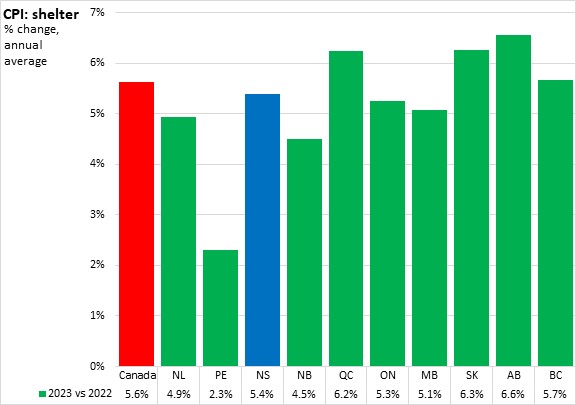
Among detailed food products with available data, Nova Scotia's average inflation in 2023 was fastest for fats and oils, preserved fruit and chicken. The slowest food price growth was reported for pork, fish and cheese.
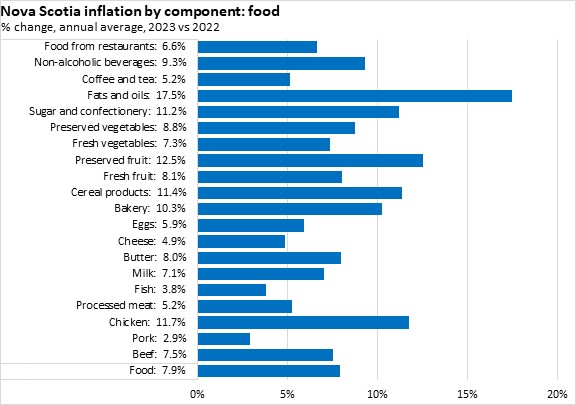
In detailed shelter cost components, rent and home/mortgage insurance reported the fastest average inflation in 2023. Fuel oil reported the only decline in prices compared to 2022.
Household operations/furnishings costs were up 0.2% overall in 2023. Prices increased the most for cleaning products followed by paper, plastic and aluminium products. The largest declines were in telephones, child care/housekeeping and internet.
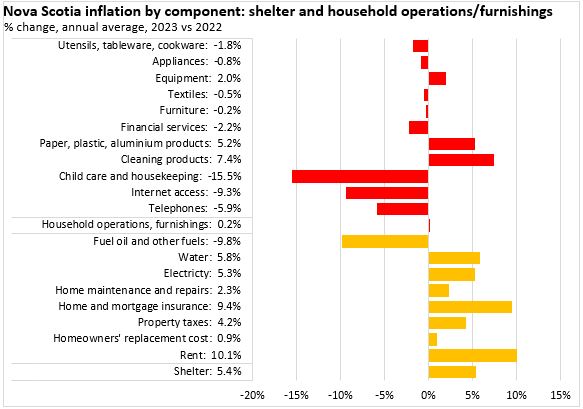
Overall transportations costs were up 1.0% on average in 2023, with the largest increase reported for taxi and other local transportation. Inter-city transportation and gasoline had the largest average price declines in 2023.
Health and personal care costs were up 6.9% in 2023 with gains in all sub-components led by personal care supplies.
Clothing and footwear prices were up 2.6% in 2023 with increases in all categories. Men's clothing reported the largest increase compared to 2022.
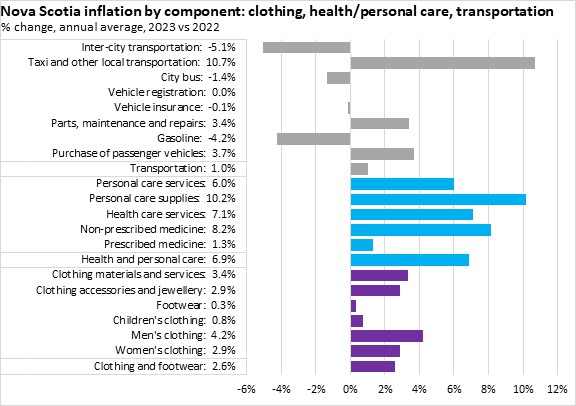
Nova Scotia's overall prices for recreation, education and reading were up 3.7% on average in 2023. The fastest price increases were in travel services while home entertainment equipment and services reported the only drop in prices.
Nova Scotia's prices for alcohol, tobacco and recreational cannabis were up 5.2% in 2023 with gains in all categories except cannabis.
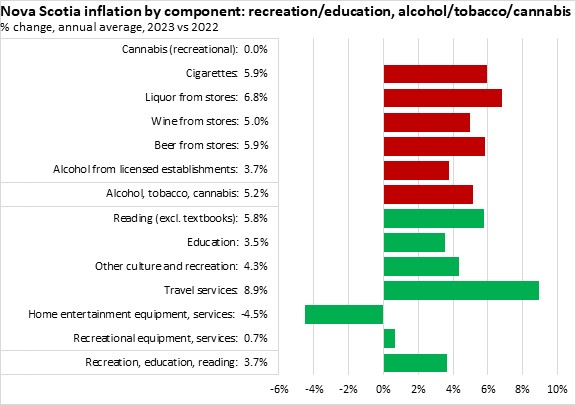
Trends
From 2012 to 2020 Nova Scotia's all items CPI inflation remained within the 0% to 2% range, averaging 1.3% growth per year. Inflation accelerated to 4.1% in 2021, and again to 7.5% in 2022, before slowing to 4.0% in 2023. Excluding energy and food prices, Nova Scotia's inflation was more stable through the 2010s, averaging 1.6% growth per year. Starting in 2021, inflation in prices excluding food and energy increased to 2.5%, then 4.3% in 2022, before slowing slightly to 4.2% in 2023.
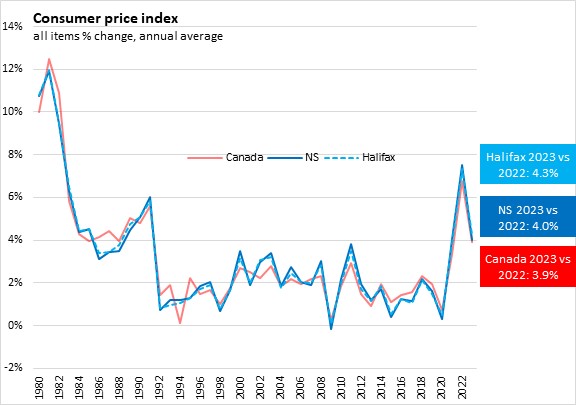
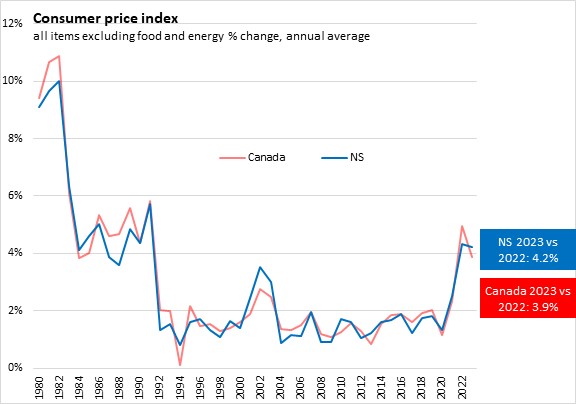
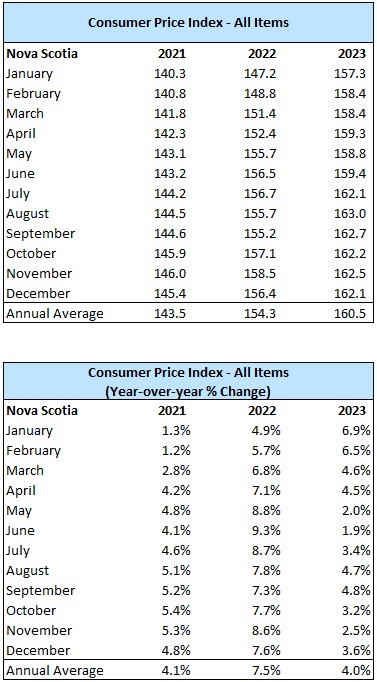
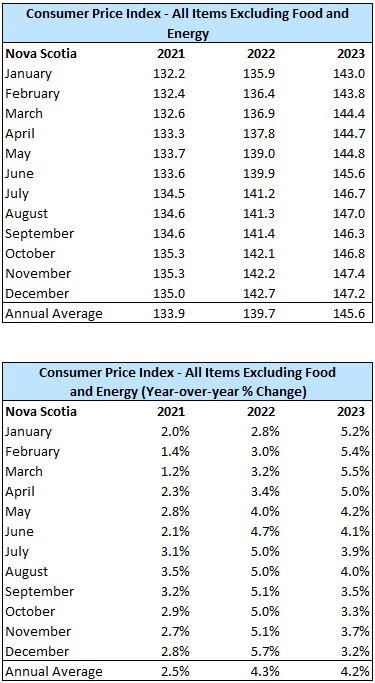
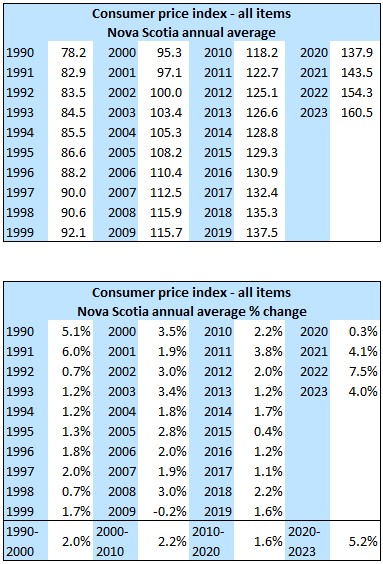
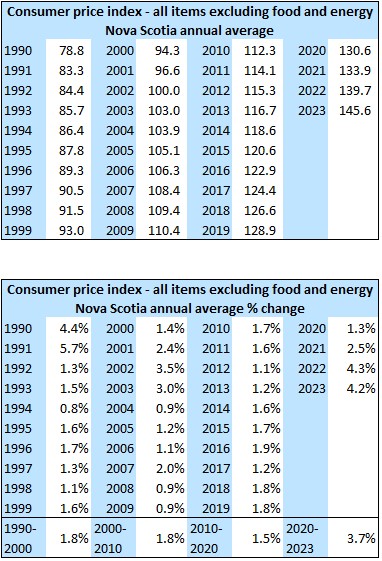
Source: Statistics Canada. Table 18-10-0004-01 Consumer Price Index, monthly, not seasonally adjusted; Table 18-10-0256-01 Consumer Price Index (CPI) statistics, measures of core inflation and other related statistics - Bank of Canada definitions; Table 18-10-0005-01 Consumer Price Index, annual average, not seasonally adjusted CONSUMER PRICE INDEX, DECEMBER & ANNUAL 2023
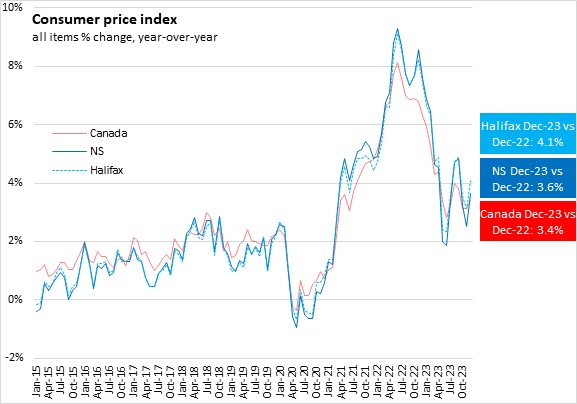
Year-over-year (December 2023 vs December 2022)
All items: Consumer prices in Nova Scotia increased 3.6%. The national average inflation was 3.4%. In Halifax consumer prices increased 4.1%.
All items excluding food and energy: Nova Scotia consumer prices outside of food and energy increased 3.2%. This was below the national average increase of 3.4%.
Month-over-month (December 2023 vs November 2023)
All items: Consumer prices in Nova Scotia were down -0.2%. Nationally, consumer prices were 0.3% lower than in the previous month. In Halifax consumer prices were down 0.2%.
All items excluding food and energy: Nova Scotia consumer prices excluding food and energy decreased 0.1% month over month in December 2023. Nationally, consumer prices outside of food and energy were 0.3% lower than in the previous month.
ANNUAL (2023 VS 2022)

Comparing the average of CPI in 2023 with the average in 2022, all-items CPI increased by 4.0% in Nova Scotia. National all-items CPI was up 3.9% in 2023. In Halifax, all-items CPI grew 4.3%.
Excluding food and energy, Nova Scotia's inflation was 4.2% in 2023, above the national inflation of 3.9%.
Source: Statistics Canada. Table 18-10-0004-01 Consumer Price Index, monthly, not seasonally adjusted, Table 18-10-0005-01 Consumer Price Index, annual average, not seasonally adjusted US CONSUMER PRICE INDEX, DECEMBER 2023 AND 2023 ANNUAL
The United States Consumer Price Index (not seasonally adjusted) for All Urban Consumers increased 3.4% year-over-year in December 2023. Compared to December 2022, prices were higher in food (+2.7%), shelter (+6.2%) and Transportation (+9.7%), and lower in energy (-2.0%). Notable increases over December 2022 were reported for motor vehicle insurance (+20.3%), recreation (+2.7%), personal care (+5.0%), and education (+2.4%).
The month-over-month (seasonally adjusted) change in the CPI was +0.3% in December 2023, following +0.1% in November. Over the past month shelter continued to rise (+0.4%) marking the 44th consecutive month of growth. Shelter accounted for over half of the monthly all-item CPI growth in December. The food index increased 0.2% compared to the previous month. Energy prices rose 0.4% over November with increases in electricity and gasoline offsetting declines in natural gas.
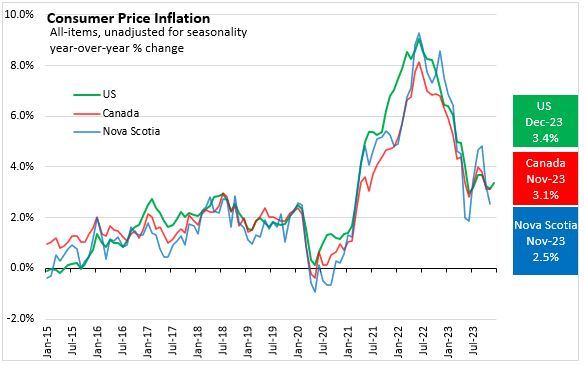
The CPI excluding food and energy rose 3.9% compared to December 2022, down slightly from 4.0% growth in the previous month. The CPI excluding food and energy index was up 0.3% compared to November 2023.
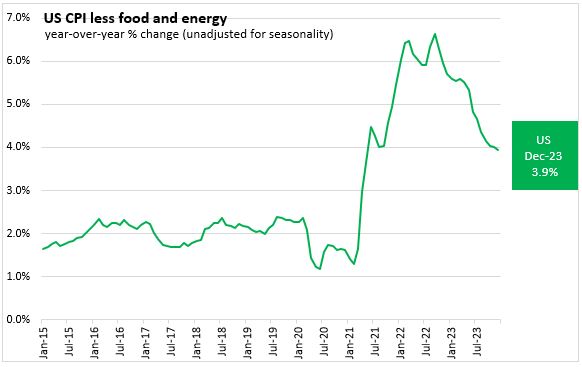
On an annual basis, the consumer price index rose 4.1% on average in 2023. US inflation has been faster than inflation in Canada or Nova Scotia since 2020, with the differences in annual price growth narrowing in 2023.
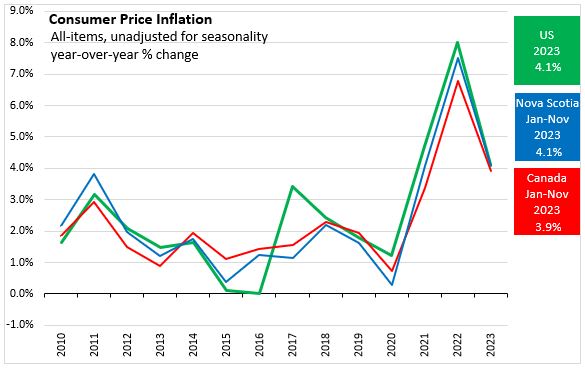
Note:
Canada and Nova Scotia December and annual 2023 CPI figures will be released on January 16, 2024.
Sources:
Statistics Canada. Table 18-10-0004-01 Consumer Price Index, monthly, not seasonally adjusted
US Bureau of Labor Statistics, retrieved from Federal Reserve Bank of St. Louis using the FRED API.
|